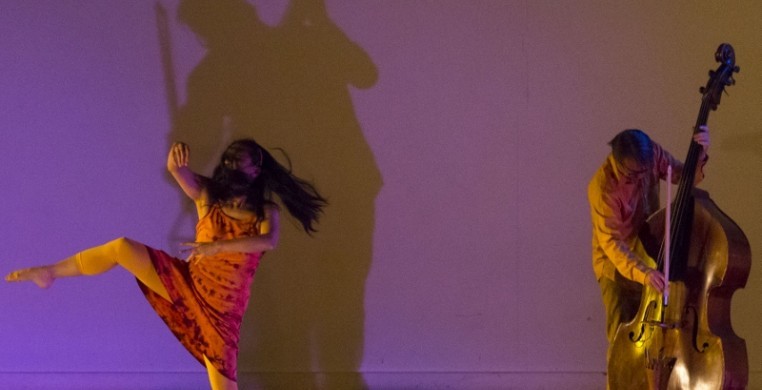For as long as Chicago Moving Company has been around (nearly 45 years), there’s at least one annual performance that gives most people an opportunity to think about something new, something strange, something entirely off the beaten path.
I’m speaking of Dance Shelter, the company’s regular smorgasbord of performances that showcases a slew of burgeoning talent and provides the occasional platform for established artists to try out fresh material. With that come at least two guarantees: nothing is ever conventional and everything has the potential to reach beyond its limitations.
I’ve grown to love that about Dance Shelter, even if the best of what many of these artists offer up is likely yet to come or in-progress. Six pieces made up Dance Shelter 2016 at the Hamlin Park Fieldhouse on May 12 and 13, and each one is every bit as audacious, complex, and unusual as audiences have come to expect. As such, expecting everything to be a home run may be expecting too much too soon, but Dance Shelter has never been about setting expectations; most of the time, it’s about beginnings.
“The Collectors” from CMC’s new artistic director Karla Beltchenko is a provocative multimedia work that almost looks to exploit movement rather than create it. In complete darkness, a series of projections dictates lots of fruitless repetitiveness. There’s an ostensible beggar peddling for change (or attention?), intercut angles of hands writing a letter. Some of the footage appears staged; other times it’s real people doing real things on the streets of London, all set to a an ear-piercing score performed live by Maxwell Citron. There are no dancers other than the ones on screen. The method had me thinking: Is life partly an exercise in futility? Not necessarily, but I enjoyed the challenge to consider it from a different vantage point.
Speaking of life, Lyndsae Rinio’s “Starless” and Helen Lee’s “Watermelon Graveyard” deal in dark themes but in wildly different ways. Rinio dresses her dancers in what could pass for hospital gowns, as if they were patients stuck in a melancholy daze. The music ranges from King Crimson to David Bowie, against a bleak motif that, ultimately, gives way to a sense of relief. A cancer survivor, Rinio is perhaps speaking to aspects of the unknown. Lee, by contrast, explores her own murky, even murderous terrors with her collaborator, Carl Wiedemann, who serves as an incarnation of Lee’s worst nightmares. For Rinio and Lee, it appears there’s more to these stories than meets they eye. Hopefully there’s more to come down the road.
Part two of the program gives way to Columbia College’s Karen Yatsko, in a solo titled “High Kicks”. Her infatuation with a plastic flamingo inspires an enthusiastic, light-hearted performance that, in a sense, is Yatsko’s attempt to gain favor from the audience. Yatsko’s approach may have some green tendencies, but there were talented tendencies, too.
For the veterans, who in the past have consistently provided the requisite glue to bind these performances together, Ayako Kato is her wonderful, reliable self in “So and so…”, a cheeky style that responds to the flirtatious plucking of double bassist Jason Roebke, while Rachel Bunting provides an excerpt of “Words from the Bellies of Stars”. Bunting’s commentary on social upheaval—deer masks and all—has the makings of something endearingly odd, yet unquestionably her own. In other words, it’s the perfect Dance Shelter closer.

